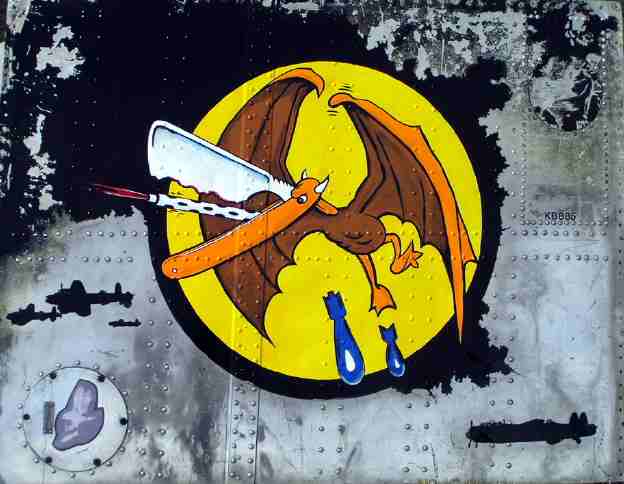 Lancaster
Lancaster  |
Media
|
Media
 Lancaster
Lancaster  |
Media
|
Media
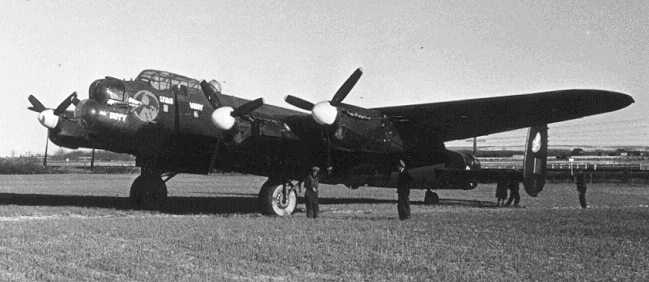
Lancaster Mk. X KB885 was built at the Victory Aircraft Plant at Malton, Ontario and ferried to a maintenance unit in England. It was assigned to No. 434 [Bluenose] Squadron in March, 1945 and the markings WL-Q were painted on the fuselage. The number of operations flown by KB885 with No. 434 Squadron and their details is not known. In April 1945, the aircraft was transferred to No. 420 [Snowy Owl] Squadron based at Tholthorpe, Yorkshire, England. Here the aircraft was assigned the code letters PT-Y.
|
However the war in Europe ended before KB885 could fly combat operations with its new squadron. No. 420 Squadron returned to Canada on 14 June, 1945, and prepared for duty in the Pacific as part of "Tiger-Force." The dropping of the two atomic bombs and the total surrender of Japan ended the Second World War on 15 August, 1945. No. 420 Squadron was disbanded at Debert, Nova Scotia on 5 September, 1945. |
|
On 8 September, 1945, KB885 arrived at Pearce, Alberta together with 82 other Canadian built Lancaster veterans. In the next three months all these aircraft were flown to different RCAF bases in Alberta and placed into long-term storage. KB885 was flown to what was formerly #37 Service Flying Training School in Calgary and placed in a hangar. In 1947, the Canadian Government decided to sell a number of Lancasters. The RCAF struck KB885 off strength and sold it to C.R. "Charlie" Parker of Red Deer, Alberta for $275.00. The aircraft was flown to Penhold (formerly the site of #36 SFTS under the BCATP), where she appeared at an open house air show on 11-12 June.
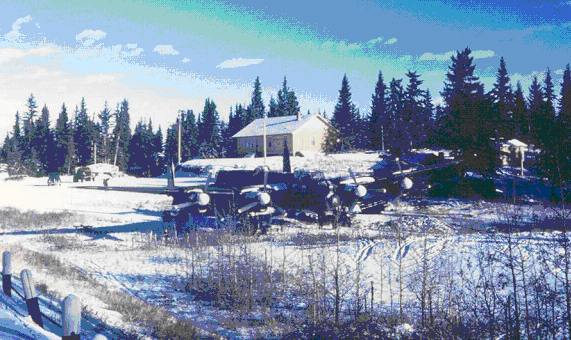 KB885 stuck in wet ground on the way to Charlie Parker's gas station, Late 1947. |
Charlie saw his new Lancaster as a potential magnet to draw customers to his service station on Highway #2, about one mile south of Red Deer. His daughter, Lois Gilmour recalled, "Dad was always full of ideas that were different. He could fix or build almost anything, really a great inventor of machinery, etc., and loved cars and planes. I'm sure people around here wondered about him -but they were in awe when he set his plan in motion." Mr. Parker began to tow his new bomber from the Penhold base on country roads and across farm fields. For a time it was bogged down in wet ground but finally, after the ground froze, it completed its trip to Charlie's gas station that he named, "Bomber Service." |
The Lancaster's undercarriage was set on concrete supports and steps were constructed so that visitors could view the interior as part of a 25 cent tour. Later the admission charge was dropped. Lois Gilmour recalled how fun it was to work at the gas station and to tour people through the aircraft. |
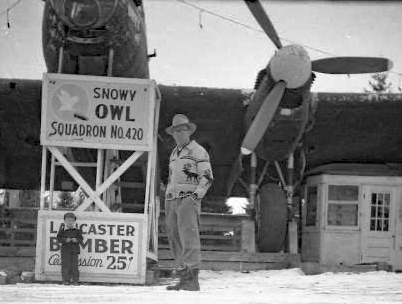
|
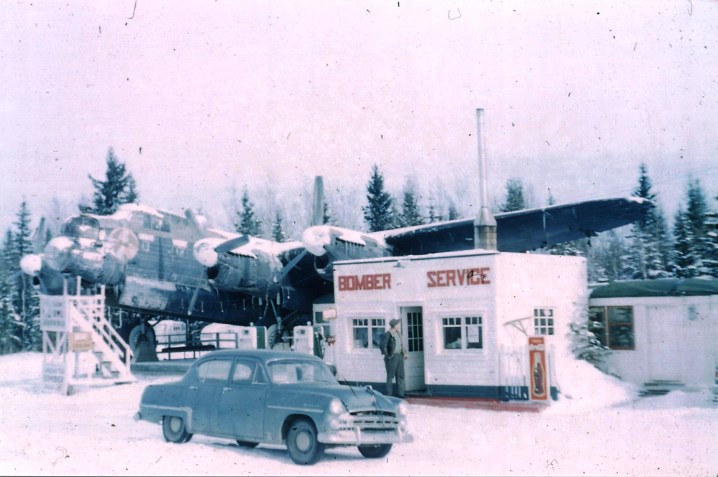
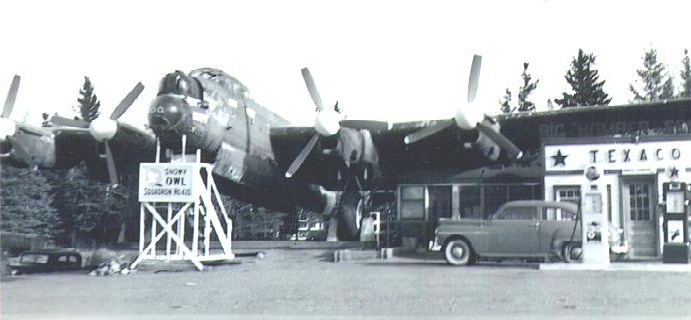
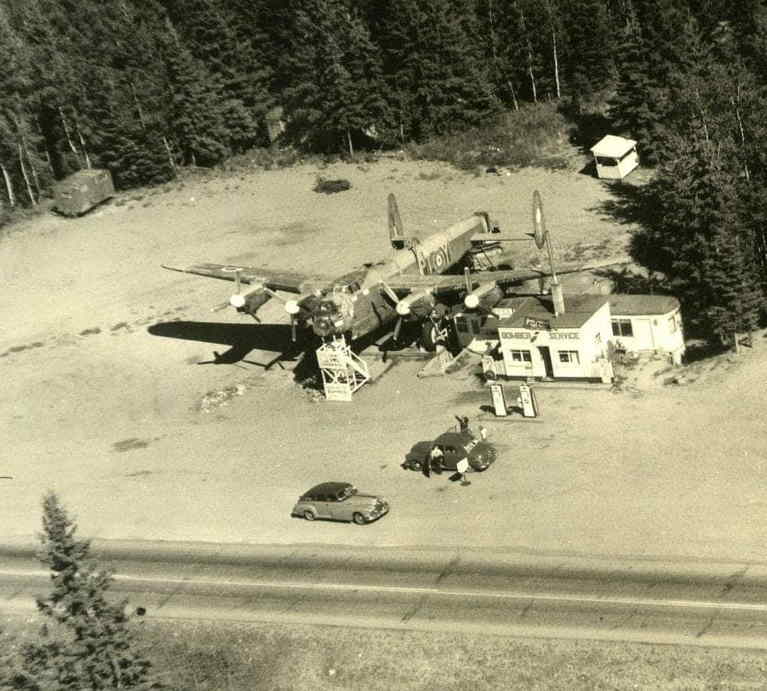
Health reasons forced Charlie Parker to sell "Bomber Service" in 1954. Two years later, the business was purchased by Walter Mielke. Mr. Mielke was approached by Troutdale Airmotive Company of Troutdale, Oregon, who offered to purchase the Lancaster for $6000 and convert it into a fire-fighting water bomber. The offer was accepted on the condition that Troutdale purchase a surplus P-40 Kittyhawk from the RCAF base at Vulcan and move it to "Bomber Service" to replace the Lancaster.
Preparations then began to make the Lancaster airworthy and ferry KB885 to California for licensing and then to Portland, Oregon to be modified to become a water bomber. The cost to prepare the aircraft for flight was estimated to be $14,000. James Sproat, a Portland pilot who was to fly the aircraft to California, was reported as saying that the bomber was to carry 4000 gallons of water and would be able to lay a 200 foot swath of water, one inch deep in the path of an advancing fire.
The weather was good in the fall of 1956 as two air force mechanics from the Penhold base assisted with preparing KB885 for flight. New Rolls-Royce Merlin engines were fitted and run-up, the elevators, ailerons, and rudders, were refurbished, new tires were installed, and a makeshift runway was bulldozed in a nearby field.
The Calgary Herald reported that, "When the engines were started, early morning motorists who probably had no thought that the machine would ever fly again, stopped to confirm their disbelieving eyes. Nearly everyone who went by slowed their cars to a crawl as they watched the propellers cutting through the air."
 KB885 after the fire; 1957. |
But a happy ending to the saga of KB885 was not to be. As the big moment arrived in January, 1957, pilot-mechanic E. Robinson taxied the Lancaster through the snow to her new runway. Just before take-off hydraulic problems developed and while Robinson worked on the hydraulic system a fire ignited in the interior of the nose section. Before it was extinguished the complete nose section burned off and fell to the snow. The once proud bomber was towed back to the service station and later sold for scrap. |
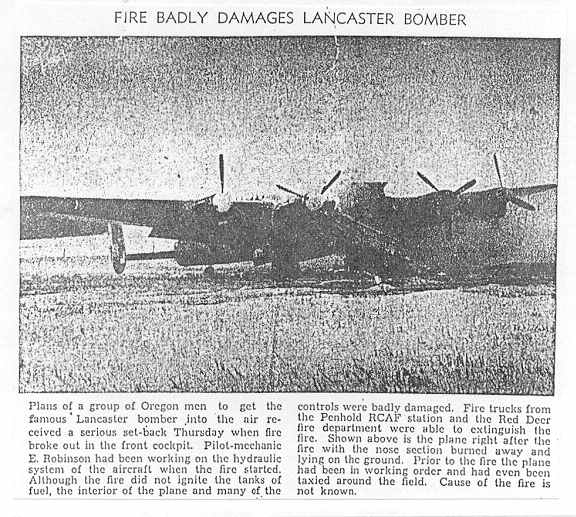

Regarding the wartime nose and tail art carried by KB885, like all Lancasters of No. 420 Squadron it had the snowy owl painted on the outside of both tail fins. As well, PT-Y carried very distinctive nose art titled, "Hell Razor." |
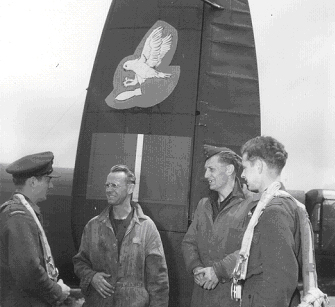 No. 420 Squadron's insignia was painted on the tail fins of KB885. |
